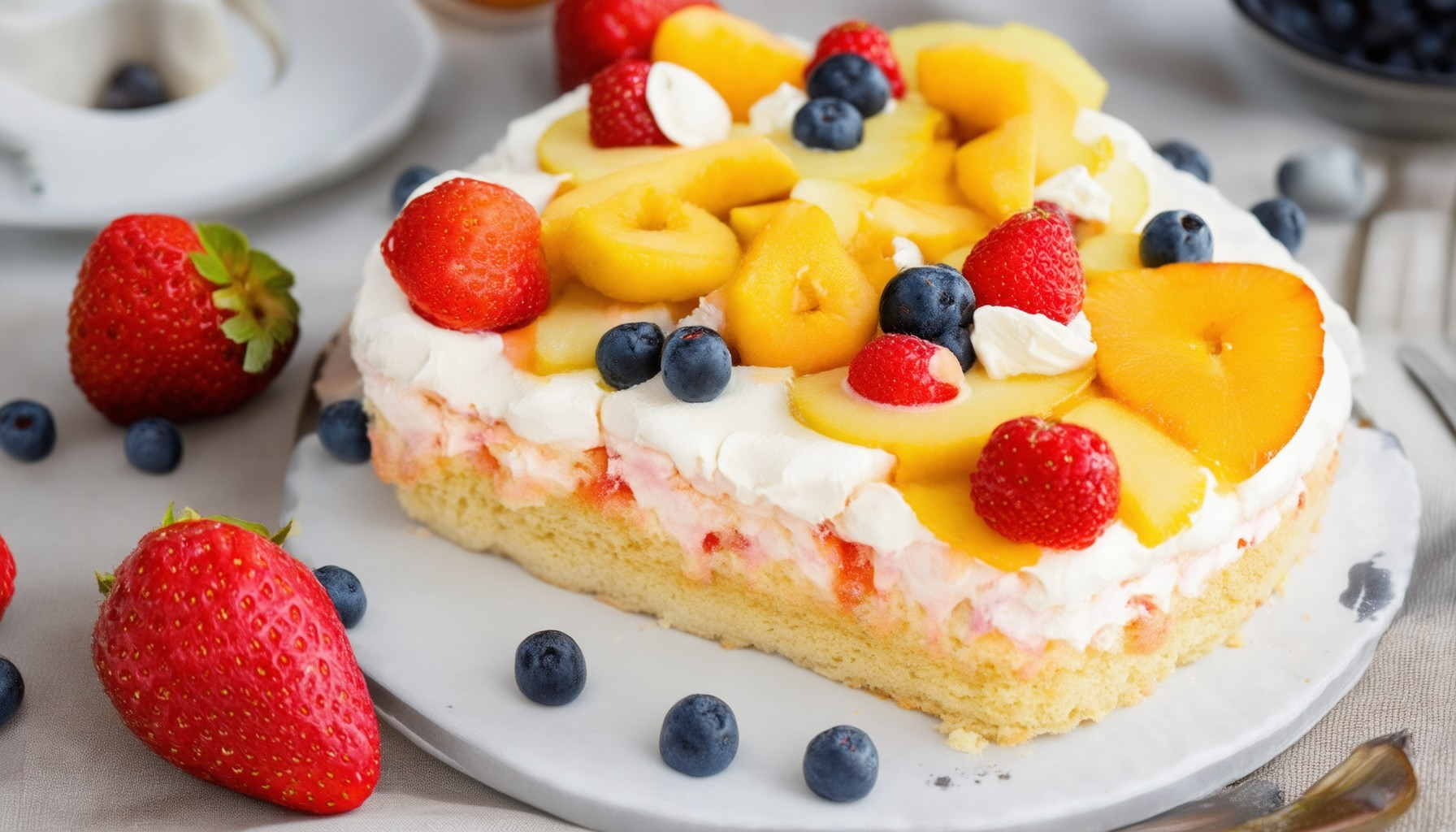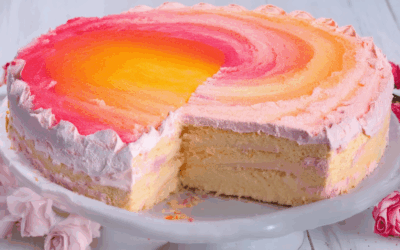Fruit-topped cakes have long been a beloved dessert option, offering a delightful combination of sweetness and freshness. Whether you’re planning a special occasion or simply looking for a delicious treat, fruit-topped cakes provide a versatile canvas for creativity. From classic sponge cakes adorned with ripe berries to more exotic varieties, these desserts cater to a wide range of tastes and preferences. In this guide, we’ll explore everything you need to know about fruit-topped cakes, including the best fruits to use, regional variations, and expert tips for achieving the perfect dessert. Whether you’re a seasoned baker or new to the kitchen, this article will equip you with the knowledge to create fruit-topped cakes that are as visually appealing as they are flavorful. Discover how fresh fruits can elevate your baking projects and learn about the health benefits of incorporating fruit into your favorite treats. Join us as we dive into the world of fruit-topped cakes and unlock the secrets to making cakes that are as satisfying as they are beautiful.
Key Takeaways
- In the UK, fruit cakes are a staple dessert, known for their rich fruit flavor and versatility in both traditional and modern baking.
- Try the Scottish “Biscuit Fruit Cake” for a traditional, moist treat with a rich history.
- Northern Ireland adds unique twists to their fruit cakes, blending local ingredients and regional flavors.
- The term “fruitcake” carries dual meanings—while it simply refers to a cake with fruits in culinary contexts, it has acquired a slang meaning in everyday language.
- Historical bans on fruit cakes, such as those imposed by sumptuary laws in 17th-century Europe, highlight their past as symbols of luxury and status.
- Experience Wales’ “Bara Brith,” a tea-infused fruit loaf that’s perfect for enjoying during afternoon tea.
- Make your own fruit cake by combining flour, sugar, dried fruits, spices, and tea for an authentic and customizable dessert experience.
- Serve warm fruit cakes with a cup of tea or coffee, or elevate them with clotted cream, jam, or a dollop of butter for added richness.
- Fruit cakes hold a special place in cultural traditions, often enjoyed at weddings, family gatherings, and festive celebrations.

What is the Cake with Fruit on Top?
A cake with fruit on top is a dessert that combines the rich flavors of cake with the freshness of ripe fruits. This type of dessert can vary widely depending on the ingredients used and the intended purpose. Here are some common interpretations:
- Fruit-Topped Cakes : These are often made by placing fresh fruits, such as strawberries, blueberries, or peaches, on top of a base of cake or pastry. The fruits are typically sliced or diced and may be sweetened slightly before being added to the cake.
- Fruit Cakes : In some contexts, “fruit cake” refers to a dense, moist cake loaded with dried fruits such as raisins, figs, or dates. These cakes are often associated with holiday baking or traditional recipes.
- Tart or Flan Cakes : In some cultures, a cake with fruit on top may refer to a tart or flan cake, which features a filling made from custard or cream and topped with seasonal fruits.
- Layer Cakes : Some layered cakes incorporate fruit between layers or as a topping, creating a visually appealing and flavorful dessert.
Common fruits used in these cakes include berries, citrus fruits, apples, pears, and tropical fruits like mangoes or pineapples. The choice of fruit depends on availability, personal preference, and the dish’s cultural background.
If you’re looking for a specific recipe or type of cake with fruit on top, consider exploring traditional desserts from around the world, such as the French fruit tart (fruits à la crème), the Italian tiramisu (though this includes coffee and cocoa), or the German apfelkuchen (apple cake).
For the best results, fresh, ripe fruits are recommended for their natural sweetness and texture. Pairing them with a complementary cake base ensures a balanced and delightful dessert experience.
What Fruit to Put on Top of a Cake?
When deciding which fruit to place on top of a cake, consider both taste and aesthetics. Here are some popular choices:
- Strawberries : A classic choice for strawberry cakes, offering a sweet and juicy topping.
- Raspberries and Blackberries : Delicate flavors that add a tart contrast to rich cakes like red velvet.
- Blueberries : Perfect for both sweet and savory dishes, they add a burst of flavor to morning cakes.
- Pineapple : A tropical option that pairs well with carrot cakes for added sweetness and moisture.
- Mango : A tropical fruit that adds a creamy texture and tropical twist to cakes.
- Grapes : A elegant choice for both sweet and savory cakes, offering a crunchy texture.
- Kiwi : Bright and colorful, kiwi adds a refreshing tang to cakes like banana bread.
- Lemon Zest : A citrus option that enhances the brightness of lemon or lime cakes.
- Orange or Lime Wedges : Great for garnishing cakes that feature citrus flavors.
- Coconut Flakes : Adds a tropical touch and crunch to German chocolate or carrot cakes.
- Pecan Pieces : A nutty addition that complements rich, dark chocolate cakes.
Choose fruits based on the cake’s flavor profile and your personal preference for texture and taste. Fresh berries, citrus zest, and tropical fruits are among the most popular choices for enhancing both the appearance and flavor of a cake.

Alternative Names for a Fruitcake Cake
- Dried Fruit Cake
- Mixed Fruit Cake
- Raisin Cake
- Fruity Cake
- Fruit and Nut Loaf

What Do the British Call Fruitcakes?
In the United Kingdom, fruitcakes are commonly referred to as “fruit cakes.” This term is widely used and understood across various regions, including England, Scotland, Wales, and Northern Ireland.
Regional Variations:
- Scotland: In Scotland, a traditional fruitcake known as the “Biscuit Fruit Cake” is a popular delicacy.
- Northern Ireland: Local bakeries may offer versions with unique twists, reflecting regional ingredients and preferences.
Clarification on Usage:
It’s important to note that while “fruitcake” is a neutral term in culinary contexts, it has acquired a colloquial meaning in English slang, often used humorously or critically to describe someone as eccentric or unconventional. However, in a baking context, it simply refers to a cake containing fruits.
Understanding these nuances helps clarify the term’s usage and cultural significance in the UK.
Why Was Fruitcake Outlawed?
In 17th-century Europe, plum pudding—a precursor to modern fruitcake—was legally banned due to its association with luxury and wealth. This prohibition was part of broader sumptuary laws, which regulated what people could consume based on their social status.
Key Reasons for the Ban:
- Sinful Richness: Plum pudding was deemed excessively rich and indulgent, aligning with moral and religious concerns about wastefulness and luxury.
- Sumptuary Laws: These laws restricted the consumption of expensive foods to maintain social hierarchies. Fruitcakes were seen as symbols of affluence, accessible only to the wealthy.
- High Cost of Ingredients: The expense of producing such a dessert made it a luxury item, further contributing to its association with the upper class.
Repeal and Legacy:
Despite the ban, plum pudding eventually returned as a traditional dessert, particularly around holiday seasons like Christmas. Its legal prohibition faded as societal norms evolved, allowing it to become a cherished treat once again.

What is a Welsh Fruit Cake Called?
The Welsh fruit cake is commonly known as Bara Brith . This traditional Welsh recipe is a rich fruit loaf made with tea, resulting in a moist and flavorful dessert. Bara Brith is a beloved treat during tea time in Wales, often paired with Welsh salted butter for extra richness.
Ingredients and Preparation:
- Ingredients : Typically include flour, sugar, dried fruits (like raisins), spices, and tea.
- Preparation : Baked in a loaf tin and allowed to cool slightly before serving. It can be enjoyed on its own or with a spread of butter.
Serving Suggestions:
- Serve Bara Brith warm with a cup of tea or coffee.
- Pair it with clotted cream or a dollop of jam for added sweetness.
History and Significance:
Bara Brith has deep roots in Welsh tradition, often associated with celebrations and family gatherings. Its robust flavor and moist texture make it a favorite across generations.
For more details on traditional Welsh recipes and baking techniques, explore our baking guides and cake decorating tutorials .





0 Comments